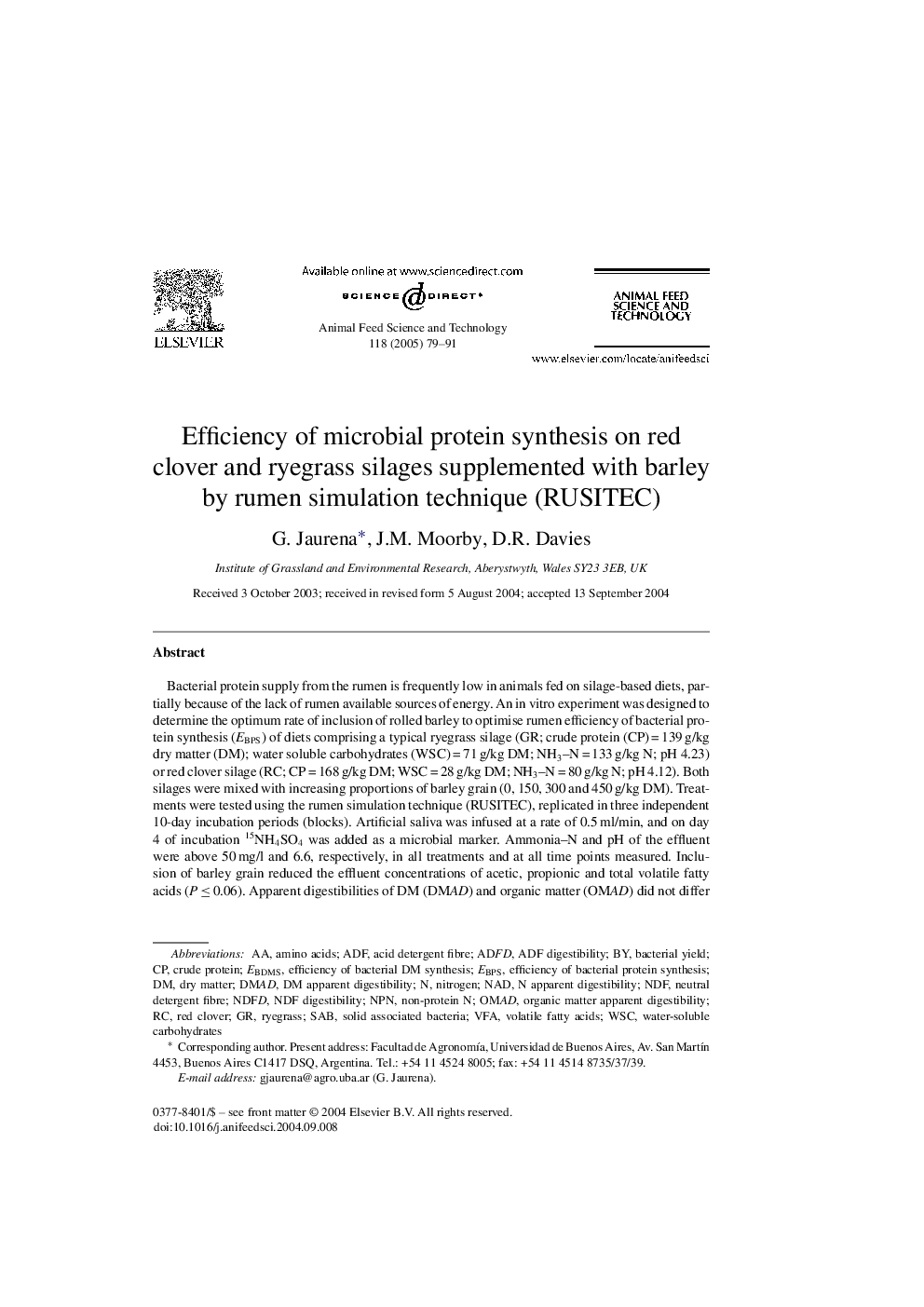| کد مقاله | کد نشریه | سال انتشار | مقاله انگلیسی | نسخه تمام متن |
|---|---|---|---|---|
| 8973857 | 1552517 | 2005 | 13 صفحه PDF | دانلود رایگان |
عنوان انگلیسی مقاله ISI
Efficiency of microbial protein synthesis on red clover and ryegrass silages supplemented with barley by rumen simulation technique (RUSITEC)
دانلود مقاله + سفارش ترجمه
دانلود مقاله ISI انگلیسی
رایگان برای ایرانیان
کلمات کلیدی
WSCRyegrassDMADNDFRUSITECNPNADFdNDFdSABNon-protein NVFANDF digestibilityOMADADFAmino acids - اسید آمینه یا آمینو اسیدVolatile fatty acids - اسیدهای چرب فرارacid detergent fibre - الیاف پاک کننده اسیدMicrobial protein synthesis - سنتز پروتئین میکروبیryegrass silage - سیلاژ ریگهراسRed clover silage - سیلاژ شبدر قرمزRed clover - شبدر قرمزneutral detergent fibre - فیبر مواد شوینده خنثیdry matter - ماده خشکNAD - نادانNitrogen - نیتروژنcrude protein - پروتئین خامWater-soluble carbohydrates - کربوهیدرات های محلول در آب
موضوعات مرتبط
علوم زیستی و بیوفناوری
علوم کشاورزی و بیولوژیک
علوم دامی و جانورشناسی
پیش نمایش صفحه اول مقاله

چکیده انگلیسی
Bacterial protein supply from the rumen is frequently low in animals fed on silage-based diets, partially because of the lack of rumen available sources of energy. An in vitro experiment was designed to determine the optimum rate of inclusion of rolled barley to optimise rumen efficiency of bacterial protein synthesis (EBPS) of diets comprising a typical ryegrass silage (GR; crude protein (CP) = 139 g/kg dry matter (DM); water soluble carbohydrates (WSC) = 71 g/kg DM; NH3-N = 133 g/kg N; pH 4.23) or red clover silage (RC; CP = 168 g/kg DM; WSC = 28 g/kg DM; NH3-N = 80 g/kg N; pH 4.12). Both silages were mixed with increasing proportions of barley grain (0, 150, 300 and 450 g/kg DM). Treatments were tested using the rumen simulation technique (RUSITEC), replicated in three independent 10-day incubation periods (blocks). Artificial saliva was infused at a rate of 0.5 ml/min, and on day 4 of incubation 15NH4SO4 was added as a microbial marker. Ammonia-N and pH of the effluent were above 50 mg/l and 6.6, respectively, in all treatments and at all time points measured. Inclusion of barley grain reduced the effluent concentrations of acetic, propionic and total volatile fatty acids (P â¤Â 0.06). Apparent digestibilities of DM (DMAD) and organic matter (OMAD) did not differ between RC or GR silages, but RC had lower (P < 0.001) neutral and acid detergent fibre digestibilities than GR silage. The effluent concentrations of acetic, propionic, butyric and total volatile fatty acids from GR was higher (P < 0.05) than from RC diets. Inclusion of barley grain linearly (P < 0.06) reduced the effluent acetic, propionic and total volatile fatty acid concentrations, but increased DMAD, OMAD and efficiency of bacterial dry matter synthesis (EBDMS). However, there was no clear response in EBPS from GR silage supplemented with barley, but in RC silage, EBPS increased up to a barley inclusion rate of 300 g/kg DM. It is concluded that rumen microorganisms reduced the amount of substrate fermented in correspondence with the increment in barley grain. The EBPS increased in RC silage by adding barley at rates of up to 300 g/kg DM. Conversely, the addition of barley to GR silage had no apparent effect on EBPS.
ناشر
Database: Elsevier - ScienceDirect (ساینس دایرکت)
Journal: Animal Feed Science and Technology - Volume 118, Issues 1â2, 3 January 2005, Pages 79-91
Journal: Animal Feed Science and Technology - Volume 118, Issues 1â2, 3 January 2005, Pages 79-91
نویسندگان
G. Jaurena, J.M. Moorby, D.R. Davies,